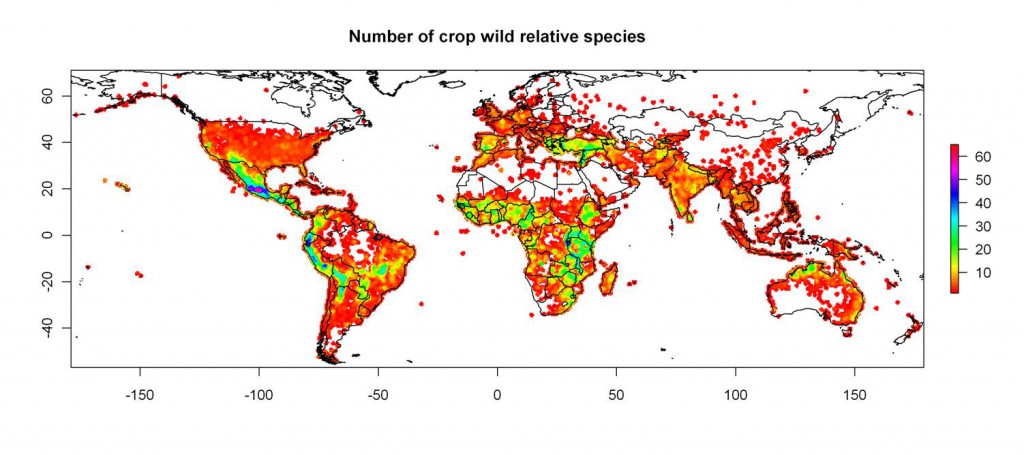- Combining traditional and scientific knowledge on an invasive species to manage forests.
- Variation in dryland trees: Balanites and Adansonia.
- Roundup of biofortification bloggers.
Markets and on farm conservation: it’s complicated
Eating blue tortilla chips during a recent visit to the US reminded me that I had intended to blog about a paper just out in the Journal of Latin American Geography. ((Alder Keleman & Jonathan Hellin (2009) Specialty maize varieties in Mexico: A case study in market-driven agro-biodiversity conservation. Journal of Latin American Geography, 8 (2), 147-174. DOI: 10.1353/lag.0.0061)) Entitled “Specialty maize varieties in Mexico: A case study in market-driven agro-biodiversity conservation,” it looks in detail at the economics of growing blue and pozole maize in the areas around the huge market represented by Mexico City. Blue maize is used to make antojitos, savoury meat-, cheese- or vegetable-filled snacks. Pozole is a traditional Mexican maize and meat soup.
 The authors, Alder Keleman and Jonathan Hellin, carried out a value chain analysis for both of these distinctive maizes and concluded that “while existing specialty markets clearly provide a strong incentive for farmers to continue to plant blue and pozole maize landraces, this in-and-of-itself … does not provide a complete in situ conservation system.” For one thing, it is not clear to what extent the demands of the market may be driving genetic “standardization” within these specialy types. And in any cases, other types of landraces are not benefiting from these markets, and may indeed be suffering as a result of them.
The authors, Alder Keleman and Jonathan Hellin, carried out a value chain analysis for both of these distinctive maizes and concluded that “while existing specialty markets clearly provide a strong incentive for farmers to continue to plant blue and pozole maize landraces, this in-and-of-itself … does not provide a complete in situ conservation system.” For one thing, it is not clear to what extent the demands of the market may be driving genetic “standardization” within these specialy types. And in any cases, other types of landraces are not benefiting from these markets, and may indeed be suffering as a result of them.
So, although on-farm conservation interventions which involve strengthening these specialty maize value chains, for example through geographical indications, may meet development goals like increasing incomes and food production, they will need to be carefully planned and implemented, and form part of a larger strategy. Which will need to involve genebanks.
Interestingly, another recent paper also looks at the role of markets in on-farm conservation in Mexico (among other things), though for another crop. ((K. Kraft, J. de Jesús Luna-Ruíz & P. Gepts (2010) Different seed selection and conservation practices for fresh market and dried chile farmers in Aguascalientes, Mexico. Economic Botany 64. 10.1007/s12231-010-9136-x. (Not yet live.) )) Kraft and co-workers found that all the landraces of green chile have disappeared in Aguascalientes due to the introduction of hybrids. Farmers still grow landraces for dried chile, in part because of laxer uniformity requirements for dried chile compared to fresh, but are open to the idea of hybrids for this market too. As with specialty maizes, the link between the market and diversity in complicated, and can go both ways. Genebanks are less fun, sure, but at least we know what they do to diversity. Mainly.
Jebel Abdul Aziz protected area to get development help
Maybe it’s the spirit of Nagoya, but the Global Arab Network is announcing that
the State Ministry for Environment Affairs, the Ministry of Agriculture, the United Nations Development Program and the local committees of the villages of Abdulaziz Mountain reserve signed on Tuesday three agreements for establishing development projects…
The aim?
…serving national communities in Abdulaziz Mountain area and reducing the effect of human activity on biodiversity in it, in addition to supporting the joint administration of the reserve’s resources among the various relevant establishments and organizing the management of the grants provided to local committees.
The Jabal Abdul Aziz protected area is in northeastern Syria, where the vegetation “represent[s] the nearest living examples to Neolithic sites along the Euphrates.”
The area clearly has eco-tourism potential. It’s also got crop wild relatives and other plant genetic resources:
The site includes a number of species that have an economical and ecological importance. Of these we mention:
(1) Genetic resources of fruit trees, Of these are: Pistacia atlantica, Pistacia khunjuk, and Amygdalus orientalis
(2) Excellent protein rich forage species. Of these we may mention Atriplex leucloda, Avena barbata, Dactylis glomerata, Salsola villosa, Stipa barbata, Aegilops spp., and Vicia spp.
(3) Medicinal plants are present in prosperous populations. Some of these species are: Thymus syriacus, Artemisia herba-alba, Capparis spinosa, Teucrium polinum, Achillea spp., Ziziphora spp.
(4) Ornamental species adapted to dry zone such as Gladiolus aleppicus, Ixiolirion tataricum and Tulipa montana are found too.
But will it be managed in such a way as to maintain these species?
Did wild relatives get a boost at Nagoya?
I think I may have Nibbled the fact that IUCN released a few days ago at Nagoya the results of a massive study of the global pattern of threat to vertebrate diversity. Here’s the money map:
Also to coincide with Nagoya, IUCN collaborated with Kew and the Natural History Museum, London on a global analysis of extinction risk for the world’s plants.
And of course, the A-Z Guide of Areas of Biodiversity Importance was launched at a side event at COP 10. The press release is on the UNEP website.
Compare and contrast with this map Julian Ramirez of CIAT has kindly sent me, showing the richness of wild relatives of a dozen or more major crops. Question for anyone who was at Nagoya: were livestock and crop wild relatives discussed during the proceedings?
I ask because in a recent posting on the Crop Wild Relatives discussion group, Nigel Maxted suggests that launching an initiative to “(establish) … a Global Network of CWR Protected Areas is now a real priority, along with systematic ex situ conservation!”
So what happened?
Nibbles: CBD COP, Biofortification, Foodie potatoes, Dates date, Reintroductions, Quercus, Nomenclature, Maize, P, Agroforestry, Weeds, VIR, Lactose intolerance, Yersinia
- Bioversity DG “jubilant” at Nagoya Protocol.
- A video plug for the biofortification conference.
- Native potatoes on foodie agenda.
- A date palm festival. In the US.
- The success of species introductions.
- Italian acorn cakes deconstructed. I’m told the people able to recognize these sweet acorns are few and old.
- Calling times on biological names. Whoa!
- Saving heirloom mielies.
- What the heck is happening with phosphorus anyway?
- Panamanian farmers don’t like to grow (some) native trees on their farms because of slow growth rates.
- Eating medieval weeds.
- Latest from Pavlovsk. I have no idea what’s going on anymore.
- Lactase persistence due to cold.
- Genetics says plague came from China.

